Corporate Law Report: Syd and Mel, Biala Case, and Company Winding Up
VerifiedAdded on 2023/01/07
|10
|2692
|62
Report
AI Summary
This report delves into various aspects of corporate law, commencing with a case study involving Syd Pty Ltd and Mel Pty Ltd, exploring the formation of a partnership, the responsibilities of the parties, and the allocation of liabilities. The report then analyzes the case of Biala Pty Ltd v Mallina Holdings Ltd (No 2), focusing on fiduciary duties and their breach within a corporate context. Finally, the report examines the circumstances under which a court may consider winding up a company under the Corporations Act s 461, providing a comprehensive overview of the legal grounds for such actions. The report provides an in-depth analysis of corporate law principles and offers insights into practical applications within the legal framework.

CORPORATE LAW
Paraphrase This Document
Need a fresh take? Get an instant paraphrase of this document with our AI Paraphraser
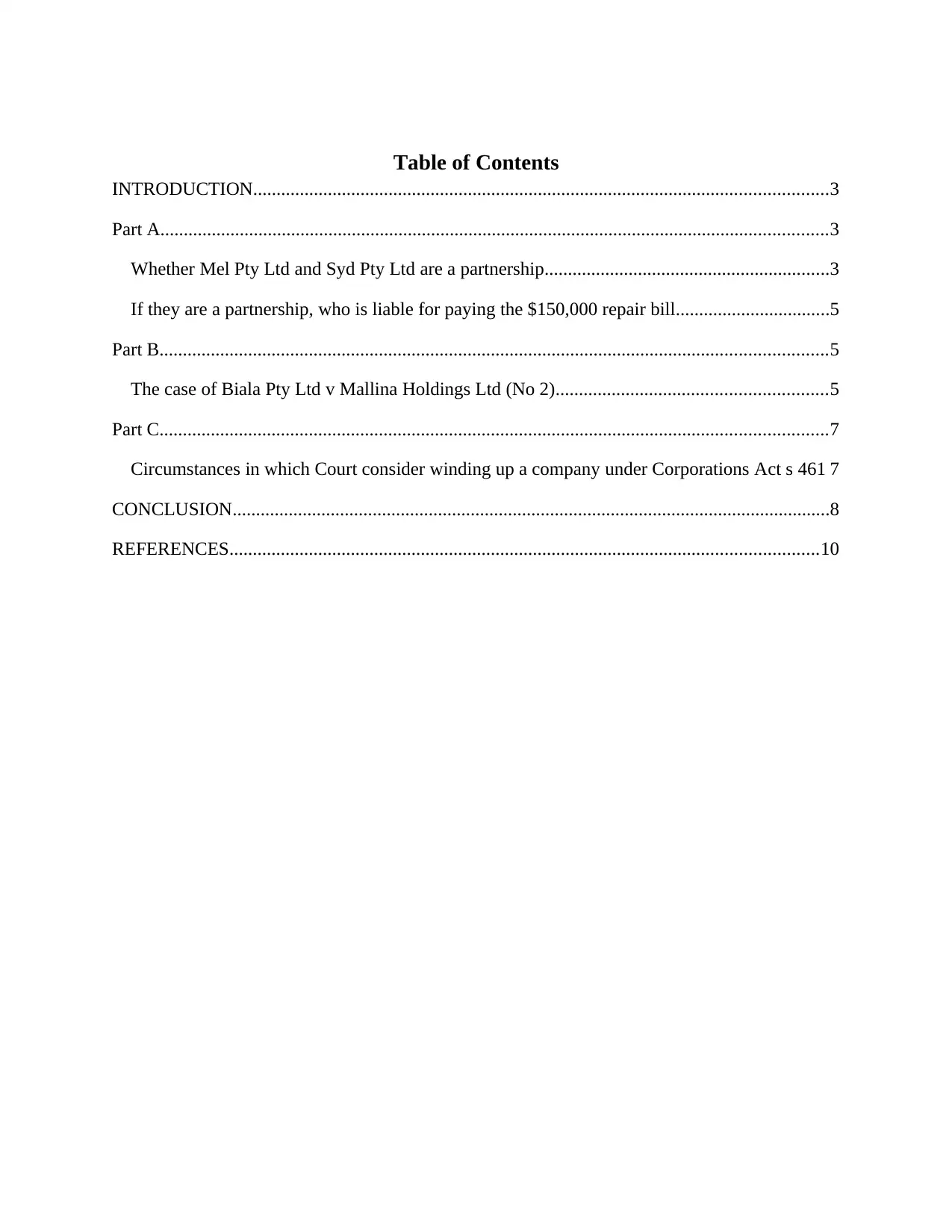
Table of Contents
INTRODUCTION...........................................................................................................................3
Part A...............................................................................................................................................3
Whether Mel Pty Ltd and Syd Pty Ltd are a partnership.............................................................3
If they are a partnership, who is liable for paying the $150,000 repair bill.................................5
Part B...............................................................................................................................................5
The case of Biala Pty Ltd v Mallina Holdings Ltd (No 2)..........................................................5
Part C...............................................................................................................................................7
Circumstances in which Court consider winding up a company under Corporations Act s 461 7
CONCLUSION................................................................................................................................8
REFERENCES..............................................................................................................................10
INTRODUCTION...........................................................................................................................3
Part A...............................................................................................................................................3
Whether Mel Pty Ltd and Syd Pty Ltd are a partnership.............................................................3
If they are a partnership, who is liable for paying the $150,000 repair bill.................................5
Part B...............................................................................................................................................5
The case of Biala Pty Ltd v Mallina Holdings Ltd (No 2)..........................................................5
Part C...............................................................................................................................................7
Circumstances in which Court consider winding up a company under Corporations Act s 461 7
CONCLUSION................................................................................................................................8
REFERENCES..............................................................................................................................10
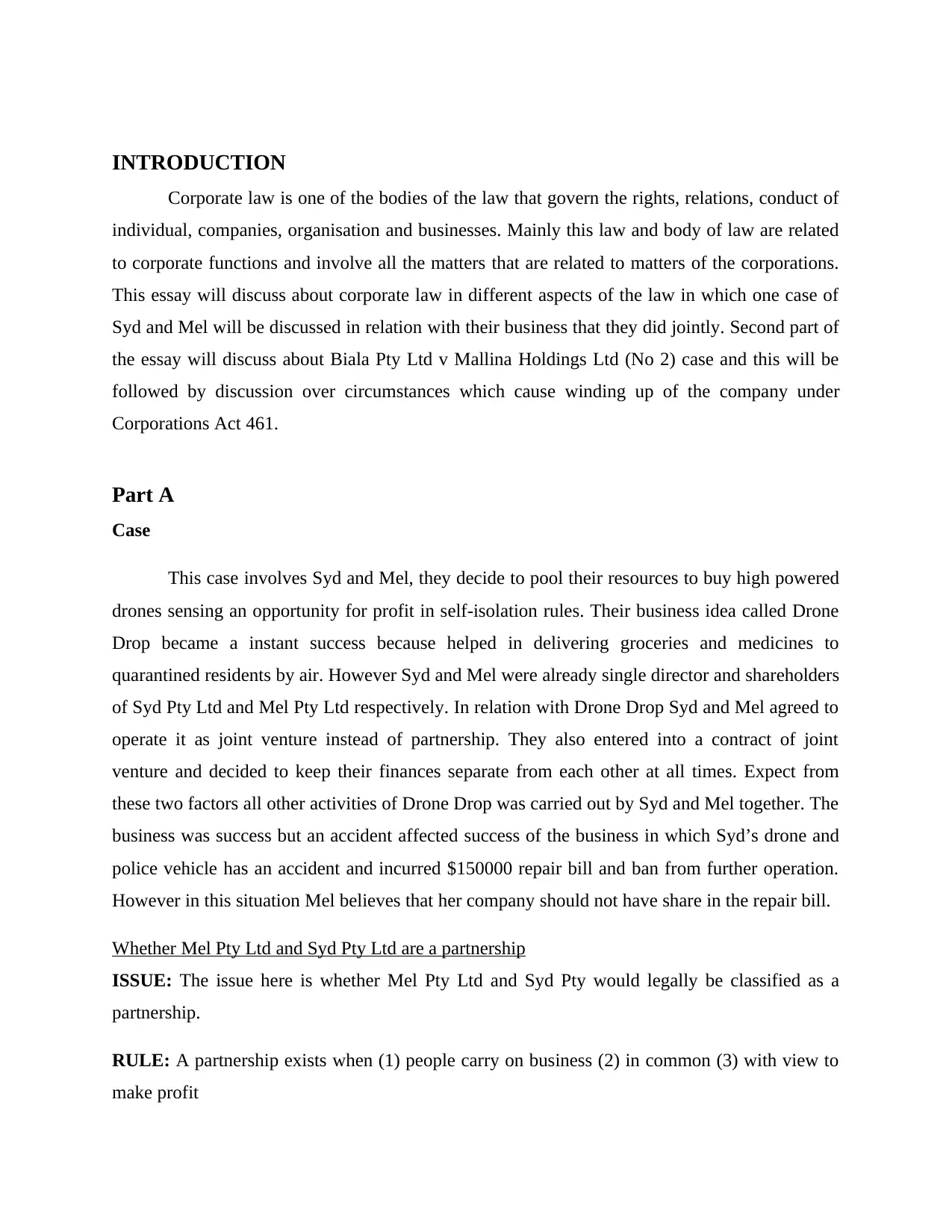
INTRODUCTION
Corporate law is one of the bodies of the law that govern the rights, relations, conduct of
individual, companies, organisation and businesses. Mainly this law and body of law are related
to corporate functions and involve all the matters that are related to matters of the corporations.
This essay will discuss about corporate law in different aspects of the law in which one case of
Syd and Mel will be discussed in relation with their business that they did jointly. Second part of
the essay will discuss about Biala Pty Ltd v Mallina Holdings Ltd (No 2) case and this will be
followed by discussion over circumstances which cause winding up of the company under
Corporations Act 461.
Part A
Case
This case involves Syd and Mel, they decide to pool their resources to buy high powered
drones sensing an opportunity for profit in self-isolation rules. Their business idea called Drone
Drop became a instant success because helped in delivering groceries and medicines to
quarantined residents by air. However Syd and Mel were already single director and shareholders
of Syd Pty Ltd and Mel Pty Ltd respectively. In relation with Drone Drop Syd and Mel agreed to
operate it as joint venture instead of partnership. They also entered into a contract of joint
venture and decided to keep their finances separate from each other at all times. Expect from
these two factors all other activities of Drone Drop was carried out by Syd and Mel together. The
business was success but an accident affected success of the business in which Syd’s drone and
police vehicle has an accident and incurred $150000 repair bill and ban from further operation.
However in this situation Mel believes that her company should not have share in the repair bill.
Whether Mel Pty Ltd and Syd Pty Ltd are a partnership
ISSUE: The issue here is whether Mel Pty Ltd and Syd Pty would legally be classified as a
partnership.
RULE: A partnership exists when (1) people carry on business (2) in common (3) with view to
make profit
Corporate law is one of the bodies of the law that govern the rights, relations, conduct of
individual, companies, organisation and businesses. Mainly this law and body of law are related
to corporate functions and involve all the matters that are related to matters of the corporations.
This essay will discuss about corporate law in different aspects of the law in which one case of
Syd and Mel will be discussed in relation with their business that they did jointly. Second part of
the essay will discuss about Biala Pty Ltd v Mallina Holdings Ltd (No 2) case and this will be
followed by discussion over circumstances which cause winding up of the company under
Corporations Act 461.
Part A
Case
This case involves Syd and Mel, they decide to pool their resources to buy high powered
drones sensing an opportunity for profit in self-isolation rules. Their business idea called Drone
Drop became a instant success because helped in delivering groceries and medicines to
quarantined residents by air. However Syd and Mel were already single director and shareholders
of Syd Pty Ltd and Mel Pty Ltd respectively. In relation with Drone Drop Syd and Mel agreed to
operate it as joint venture instead of partnership. They also entered into a contract of joint
venture and decided to keep their finances separate from each other at all times. Expect from
these two factors all other activities of Drone Drop was carried out by Syd and Mel together. The
business was success but an accident affected success of the business in which Syd’s drone and
police vehicle has an accident and incurred $150000 repair bill and ban from further operation.
However in this situation Mel believes that her company should not have share in the repair bill.
Whether Mel Pty Ltd and Syd Pty Ltd are a partnership
ISSUE: The issue here is whether Mel Pty Ltd and Syd Pty would legally be classified as a
partnership.
RULE: A partnership exists when (1) people carry on business (2) in common (3) with view to
make profit
⊘ This is a preview!⊘
Do you want full access?
Subscribe today to unlock all pages.

Trusted by 1+ million students worldwide
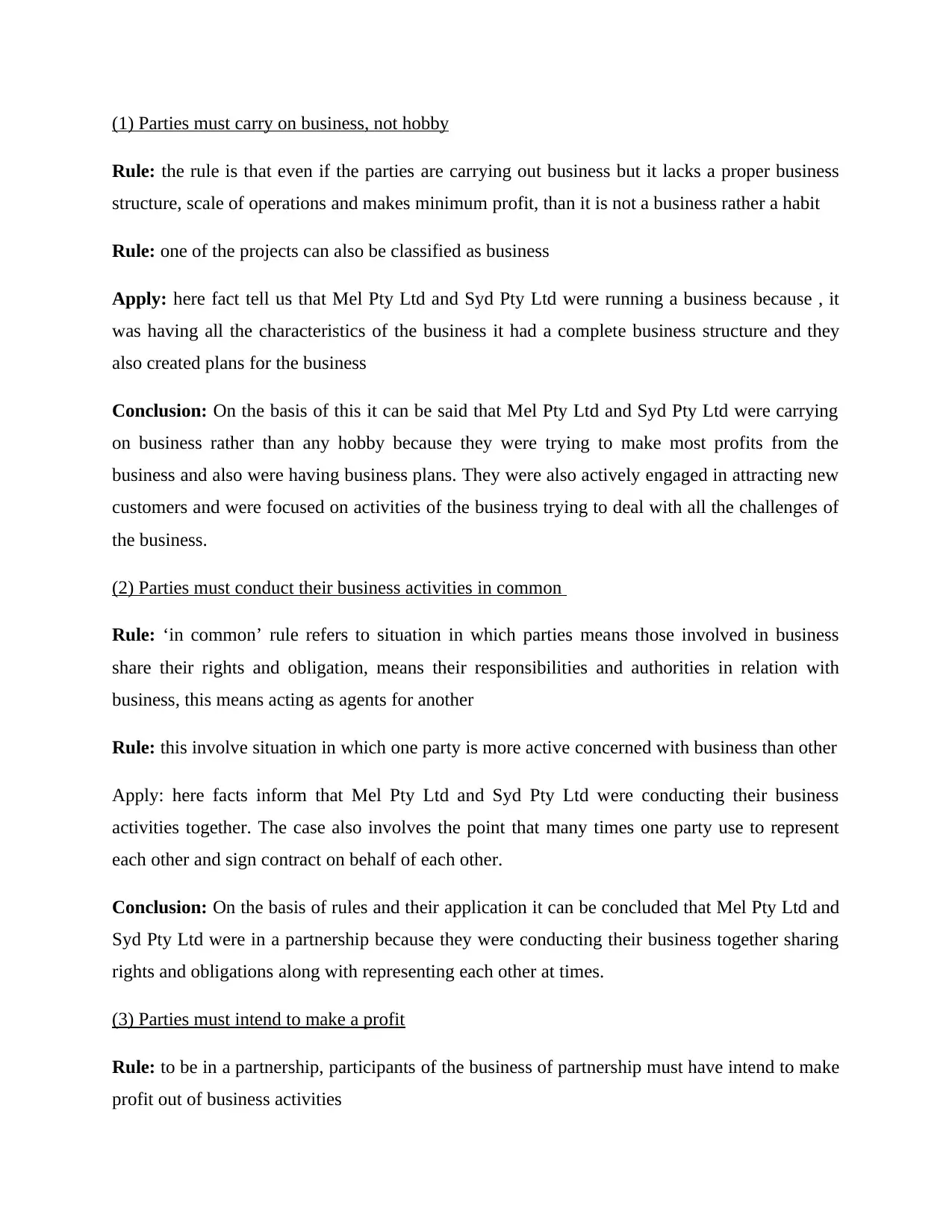
(1) Parties must carry on business, not hobby
Rule: the rule is that even if the parties are carrying out business but it lacks a proper business
structure, scale of operations and makes minimum profit, than it is not a business rather a habit
Rule: one of the projects can also be classified as business
Apply: here fact tell us that Mel Pty Ltd and Syd Pty Ltd were running a business because , it
was having all the characteristics of the business it had a complete business structure and they
also created plans for the business
Conclusion: On the basis of this it can be said that Mel Pty Ltd and Syd Pty Ltd were carrying
on business rather than any hobby because they were trying to make most profits from the
business and also were having business plans. They were also actively engaged in attracting new
customers and were focused on activities of the business trying to deal with all the challenges of
the business.
(2) Parties must conduct their business activities in common
Rule: ‘in common’ rule refers to situation in which parties means those involved in business
share their rights and obligation, means their responsibilities and authorities in relation with
business, this means acting as agents for another
Rule: this involve situation in which one party is more active concerned with business than other
Apply: here facts inform that Mel Pty Ltd and Syd Pty Ltd were conducting their business
activities together. The case also involves the point that many times one party use to represent
each other and sign contract on behalf of each other.
Conclusion: On the basis of rules and their application it can be concluded that Mel Pty Ltd and
Syd Pty Ltd were in a partnership because they were conducting their business together sharing
rights and obligations along with representing each other at times.
(3) Parties must intend to make a profit
Rule: to be in a partnership, participants of the business of partnership must have intend to make
profit out of business activities
Rule: the rule is that even if the parties are carrying out business but it lacks a proper business
structure, scale of operations and makes minimum profit, than it is not a business rather a habit
Rule: one of the projects can also be classified as business
Apply: here fact tell us that Mel Pty Ltd and Syd Pty Ltd were running a business because , it
was having all the characteristics of the business it had a complete business structure and they
also created plans for the business
Conclusion: On the basis of this it can be said that Mel Pty Ltd and Syd Pty Ltd were carrying
on business rather than any hobby because they were trying to make most profits from the
business and also were having business plans. They were also actively engaged in attracting new
customers and were focused on activities of the business trying to deal with all the challenges of
the business.
(2) Parties must conduct their business activities in common
Rule: ‘in common’ rule refers to situation in which parties means those involved in business
share their rights and obligation, means their responsibilities and authorities in relation with
business, this means acting as agents for another
Rule: this involve situation in which one party is more active concerned with business than other
Apply: here facts inform that Mel Pty Ltd and Syd Pty Ltd were conducting their business
activities together. The case also involves the point that many times one party use to represent
each other and sign contract on behalf of each other.
Conclusion: On the basis of rules and their application it can be concluded that Mel Pty Ltd and
Syd Pty Ltd were in a partnership because they were conducting their business together sharing
rights and obligations along with representing each other at times.
(3) Parties must intend to make a profit
Rule: to be in a partnership, participants of the business of partnership must have intend to make
profit out of business activities
Paraphrase This Document
Need a fresh take? Get an instant paraphrase of this document with our AI Paraphraser
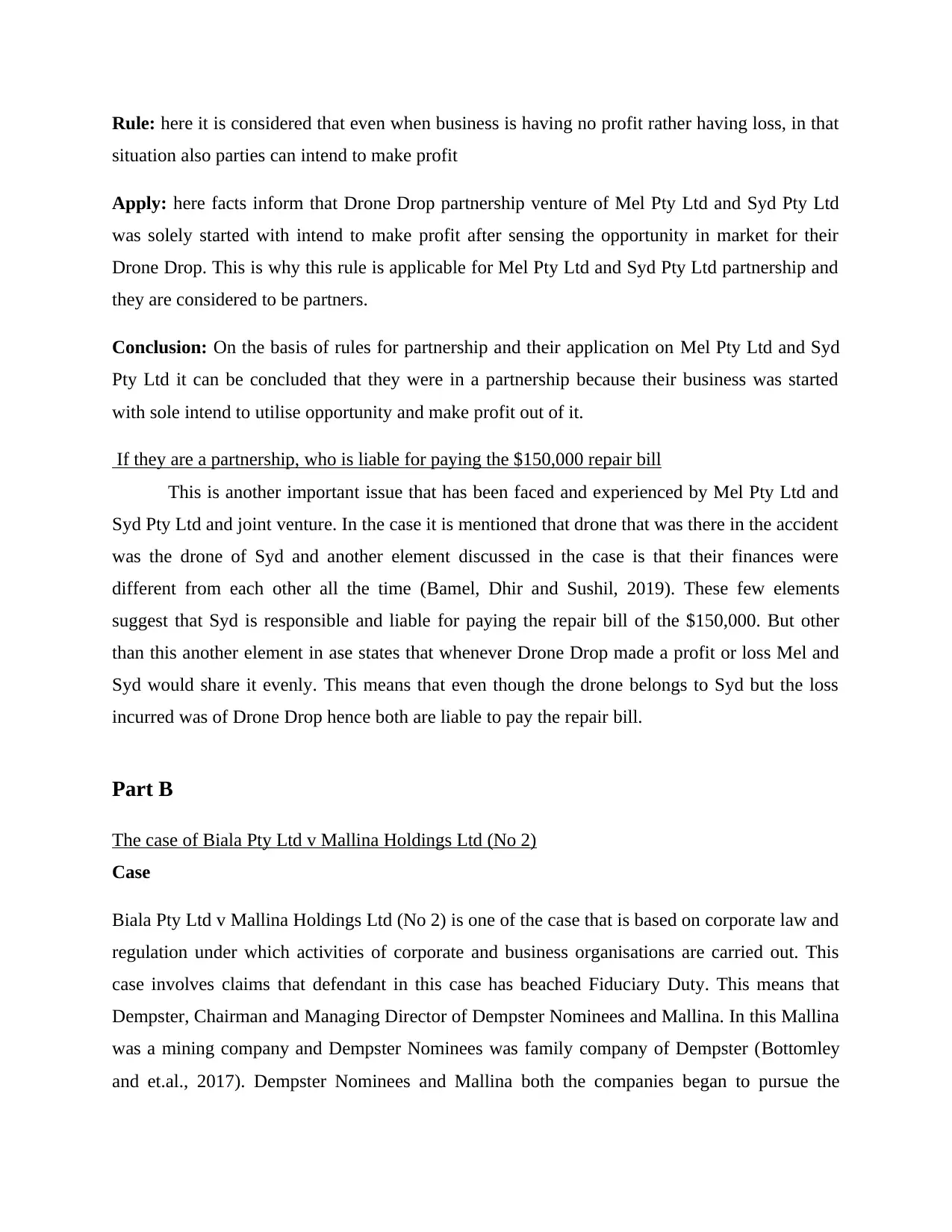
Rule: here it is considered that even when business is having no profit rather having loss, in that
situation also parties can intend to make profit
Apply: here facts inform that Drone Drop partnership venture of Mel Pty Ltd and Syd Pty Ltd
was solely started with intend to make profit after sensing the opportunity in market for their
Drone Drop. This is why this rule is applicable for Mel Pty Ltd and Syd Pty Ltd partnership and
they are considered to be partners.
Conclusion: On the basis of rules for partnership and their application on Mel Pty Ltd and Syd
Pty Ltd it can be concluded that they were in a partnership because their business was started
with sole intend to utilise opportunity and make profit out of it.
If they are a partnership, who is liable for paying the $150,000 repair bill
This is another important issue that has been faced and experienced by Mel Pty Ltd and
Syd Pty Ltd and joint venture. In the case it is mentioned that drone that was there in the accident
was the drone of Syd and another element discussed in the case is that their finances were
different from each other all the time (Bamel, Dhir and Sushil, 2019). These few elements
suggest that Syd is responsible and liable for paying the repair bill of the $150,000. But other
than this another element in ase states that whenever Drone Drop made a profit or loss Mel and
Syd would share it evenly. This means that even though the drone belongs to Syd but the loss
incurred was of Drone Drop hence both are liable to pay the repair bill.
Part B
The case of Biala Pty Ltd v Mallina Holdings Ltd (No 2)
Case
Biala Pty Ltd v Mallina Holdings Ltd (No 2) is one of the case that is based on corporate law and
regulation under which activities of corporate and business organisations are carried out. This
case involves claims that defendant in this case has beached Fiduciary Duty. This means that
Dempster, Chairman and Managing Director of Dempster Nominees and Mallina. In this Mallina
was a mining company and Dempster Nominees was family company of Dempster (Bottomley
and et.al., 2017). Dempster Nominees and Mallina both the companies began to pursue the
situation also parties can intend to make profit
Apply: here facts inform that Drone Drop partnership venture of Mel Pty Ltd and Syd Pty Ltd
was solely started with intend to make profit after sensing the opportunity in market for their
Drone Drop. This is why this rule is applicable for Mel Pty Ltd and Syd Pty Ltd partnership and
they are considered to be partners.
Conclusion: On the basis of rules for partnership and their application on Mel Pty Ltd and Syd
Pty Ltd it can be concluded that they were in a partnership because their business was started
with sole intend to utilise opportunity and make profit out of it.
If they are a partnership, who is liable for paying the $150,000 repair bill
This is another important issue that has been faced and experienced by Mel Pty Ltd and
Syd Pty Ltd and joint venture. In the case it is mentioned that drone that was there in the accident
was the drone of Syd and another element discussed in the case is that their finances were
different from each other all the time (Bamel, Dhir and Sushil, 2019). These few elements
suggest that Syd is responsible and liable for paying the repair bill of the $150,000. But other
than this another element in ase states that whenever Drone Drop made a profit or loss Mel and
Syd would share it evenly. This means that even though the drone belongs to Syd but the loss
incurred was of Drone Drop hence both are liable to pay the repair bill.
Part B
The case of Biala Pty Ltd v Mallina Holdings Ltd (No 2)
Case
Biala Pty Ltd v Mallina Holdings Ltd (No 2) is one of the case that is based on corporate law and
regulation under which activities of corporate and business organisations are carried out. This
case involves claims that defendant in this case has beached Fiduciary Duty. This means that
Dempster, Chairman and Managing Director of Dempster Nominees and Mallina. In this Mallina
was a mining company and Dempster Nominees was family company of Dempster (Bottomley
and et.al., 2017). Dempster Nominees and Mallina both the companies began to pursue the
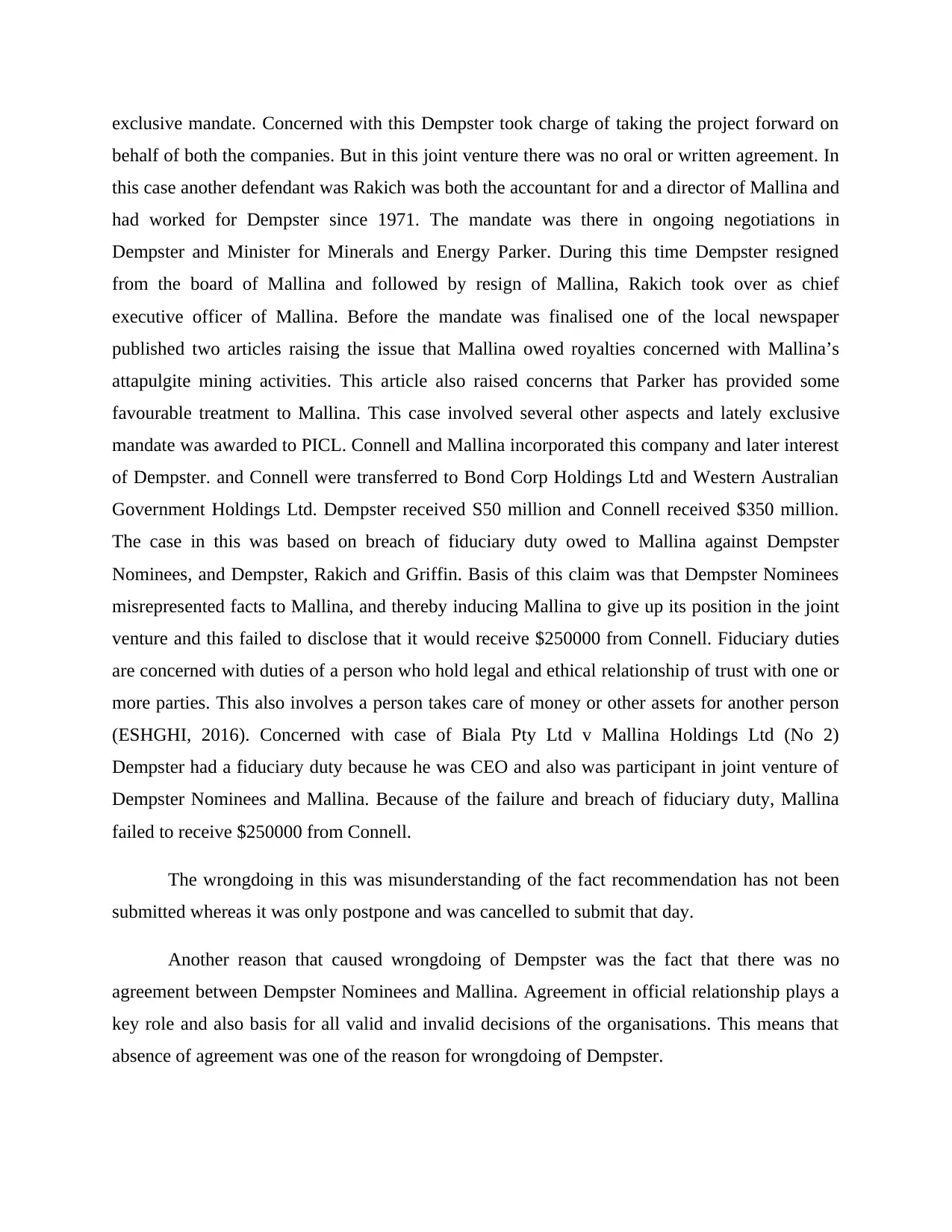
exclusive mandate. Concerned with this Dempster took charge of taking the project forward on
behalf of both the companies. But in this joint venture there was no oral or written agreement. In
this case another defendant was Rakich was both the accountant for and a director of Mallina and
had worked for Dempster since 1971. The mandate was there in ongoing negotiations in
Dempster and Minister for Minerals and Energy Parker. During this time Dempster resigned
from the board of Mallina and followed by resign of Mallina, Rakich took over as chief
executive officer of Mallina. Before the mandate was finalised one of the local newspaper
published two articles raising the issue that Mallina owed royalties concerned with Mallina’s
attapulgite mining activities. This article also raised concerns that Parker has provided some
favourable treatment to Mallina. This case involved several other aspects and lately exclusive
mandate was awarded to PICL. Connell and Mallina incorporated this company and later interest
of Dempster. and Connell were transferred to Bond Corp Holdings Ltd and Western Australian
Government Holdings Ltd. Dempster received S50 million and Connell received $350 million.
The case in this was based on breach of fiduciary duty owed to Mallina against Dempster
Nominees, and Dempster, Rakich and Griffin. Basis of this claim was that Dempster Nominees
misrepresented facts to Mallina, and thereby inducing Mallina to give up its position in the joint
venture and this failed to disclose that it would receive $250000 from Connell. Fiduciary duties
are concerned with duties of a person who hold legal and ethical relationship of trust with one or
more parties. This also involves a person takes care of money or other assets for another person
(ESHGHI, 2016). Concerned with case of Biala Pty Ltd v Mallina Holdings Ltd (No 2)
Dempster had a fiduciary duty because he was CEO and also was participant in joint venture of
Dempster Nominees and Mallina. Because of the failure and breach of fiduciary duty, Mallina
failed to receive $250000 from Connell.
The wrongdoing in this was misunderstanding of the fact recommendation has not been
submitted whereas it was only postpone and was cancelled to submit that day.
Another reason that caused wrongdoing of Dempster was the fact that there was no
agreement between Dempster Nominees and Mallina. Agreement in official relationship plays a
key role and also basis for all valid and invalid decisions of the organisations. This means that
absence of agreement was one of the reason for wrongdoing of Dempster.
behalf of both the companies. But in this joint venture there was no oral or written agreement. In
this case another defendant was Rakich was both the accountant for and a director of Mallina and
had worked for Dempster since 1971. The mandate was there in ongoing negotiations in
Dempster and Minister for Minerals and Energy Parker. During this time Dempster resigned
from the board of Mallina and followed by resign of Mallina, Rakich took over as chief
executive officer of Mallina. Before the mandate was finalised one of the local newspaper
published two articles raising the issue that Mallina owed royalties concerned with Mallina’s
attapulgite mining activities. This article also raised concerns that Parker has provided some
favourable treatment to Mallina. This case involved several other aspects and lately exclusive
mandate was awarded to PICL. Connell and Mallina incorporated this company and later interest
of Dempster. and Connell were transferred to Bond Corp Holdings Ltd and Western Australian
Government Holdings Ltd. Dempster received S50 million and Connell received $350 million.
The case in this was based on breach of fiduciary duty owed to Mallina against Dempster
Nominees, and Dempster, Rakich and Griffin. Basis of this claim was that Dempster Nominees
misrepresented facts to Mallina, and thereby inducing Mallina to give up its position in the joint
venture and this failed to disclose that it would receive $250000 from Connell. Fiduciary duties
are concerned with duties of a person who hold legal and ethical relationship of trust with one or
more parties. This also involves a person takes care of money or other assets for another person
(ESHGHI, 2016). Concerned with case of Biala Pty Ltd v Mallina Holdings Ltd (No 2)
Dempster had a fiduciary duty because he was CEO and also was participant in joint venture of
Dempster Nominees and Mallina. Because of the failure and breach of fiduciary duty, Mallina
failed to receive $250000 from Connell.
The wrongdoing in this was misunderstanding of the fact recommendation has not been
submitted whereas it was only postpone and was cancelled to submit that day.
Another reason that caused wrongdoing of Dempster was the fact that there was no
agreement between Dempster Nominees and Mallina. Agreement in official relationship plays a
key role and also basis for all valid and invalid decisions of the organisations. This means that
absence of agreement was one of the reason for wrongdoing of Dempster.
⊘ This is a preview!⊘
Do you want full access?
Subscribe today to unlock all pages.

Trusted by 1+ million students worldwide
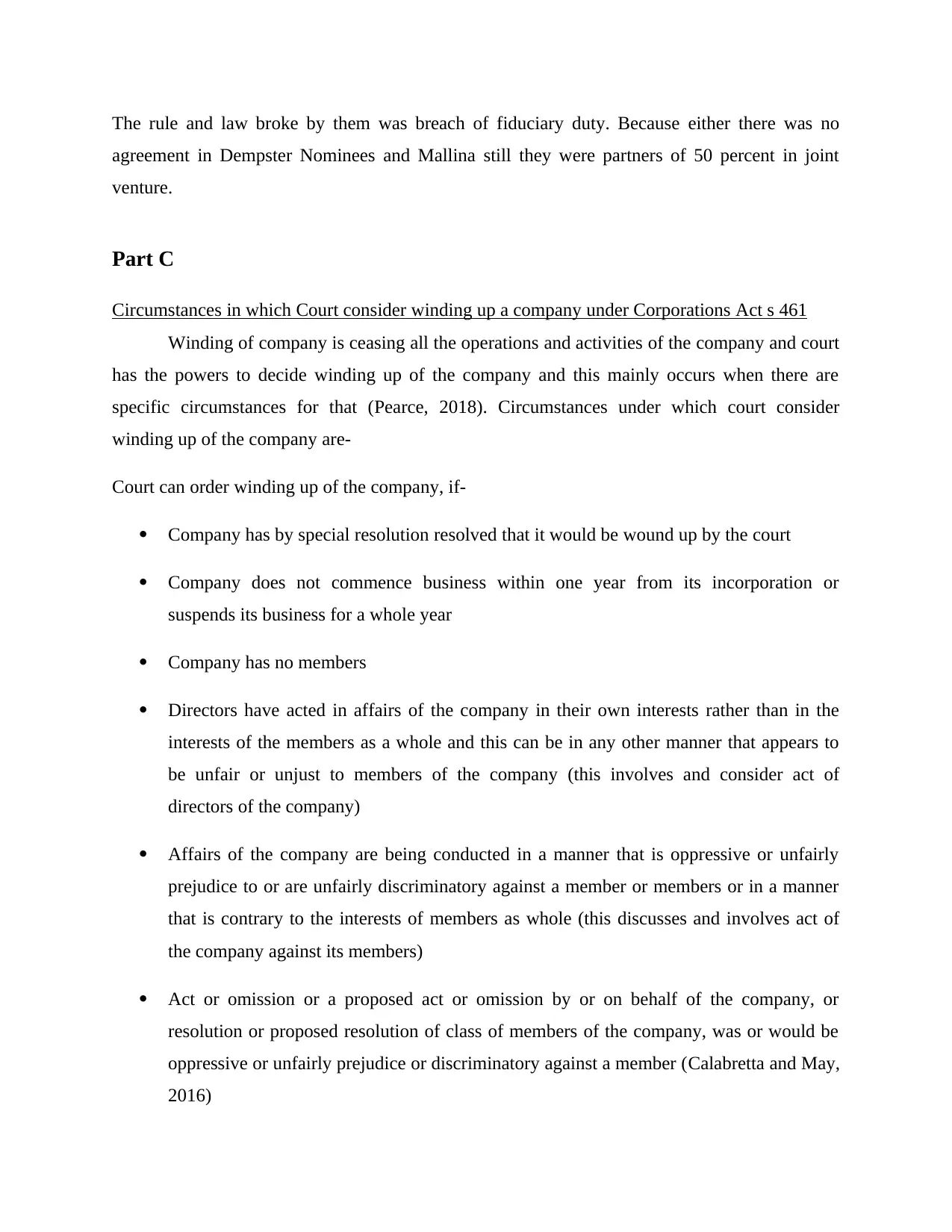
The rule and law broke by them was breach of fiduciary duty. Because either there was no
agreement in Dempster Nominees and Mallina still they were partners of 50 percent in joint
venture.
Part C
Circumstances in which Court consider winding up a company under Corporations Act s 461
Winding of company is ceasing all the operations and activities of the company and court
has the powers to decide winding up of the company and this mainly occurs when there are
specific circumstances for that (Pearce, 2018). Circumstances under which court consider
winding up of the company are-
Court can order winding up of the company, if-
Company has by special resolution resolved that it would be wound up by the court
Company does not commence business within one year from its incorporation or
suspends its business for a whole year
Company has no members
Directors have acted in affairs of the company in their own interests rather than in the
interests of the members as a whole and this can be in any other manner that appears to
be unfair or unjust to members of the company (this involves and consider act of
directors of the company)
Affairs of the company are being conducted in a manner that is oppressive or unfairly
prejudice to or are unfairly discriminatory against a member or members or in a manner
that is contrary to the interests of members as whole (this discusses and involves act of
the company against its members)
Act or omission or a proposed act or omission by or on behalf of the company, or
resolution or proposed resolution of class of members of the company, was or would be
oppressive or unfairly prejudice or discriminatory against a member (Calabretta and May,
2016)
agreement in Dempster Nominees and Mallina still they were partners of 50 percent in joint
venture.
Part C
Circumstances in which Court consider winding up a company under Corporations Act s 461
Winding of company is ceasing all the operations and activities of the company and court
has the powers to decide winding up of the company and this mainly occurs when there are
specific circumstances for that (Pearce, 2018). Circumstances under which court consider
winding up of the company are-
Court can order winding up of the company, if-
Company has by special resolution resolved that it would be wound up by the court
Company does not commence business within one year from its incorporation or
suspends its business for a whole year
Company has no members
Directors have acted in affairs of the company in their own interests rather than in the
interests of the members as a whole and this can be in any other manner that appears to
be unfair or unjust to members of the company (this involves and consider act of
directors of the company)
Affairs of the company are being conducted in a manner that is oppressive or unfairly
prejudice to or are unfairly discriminatory against a member or members or in a manner
that is contrary to the interests of members as whole (this discusses and involves act of
the company against its members)
Act or omission or a proposed act or omission by or on behalf of the company, or
resolution or proposed resolution of class of members of the company, was or would be
oppressive or unfairly prejudice or discriminatory against a member (Calabretta and May,
2016)
Paraphrase This Document
Need a fresh take? Get an instant paraphrase of this document with our AI Paraphraser
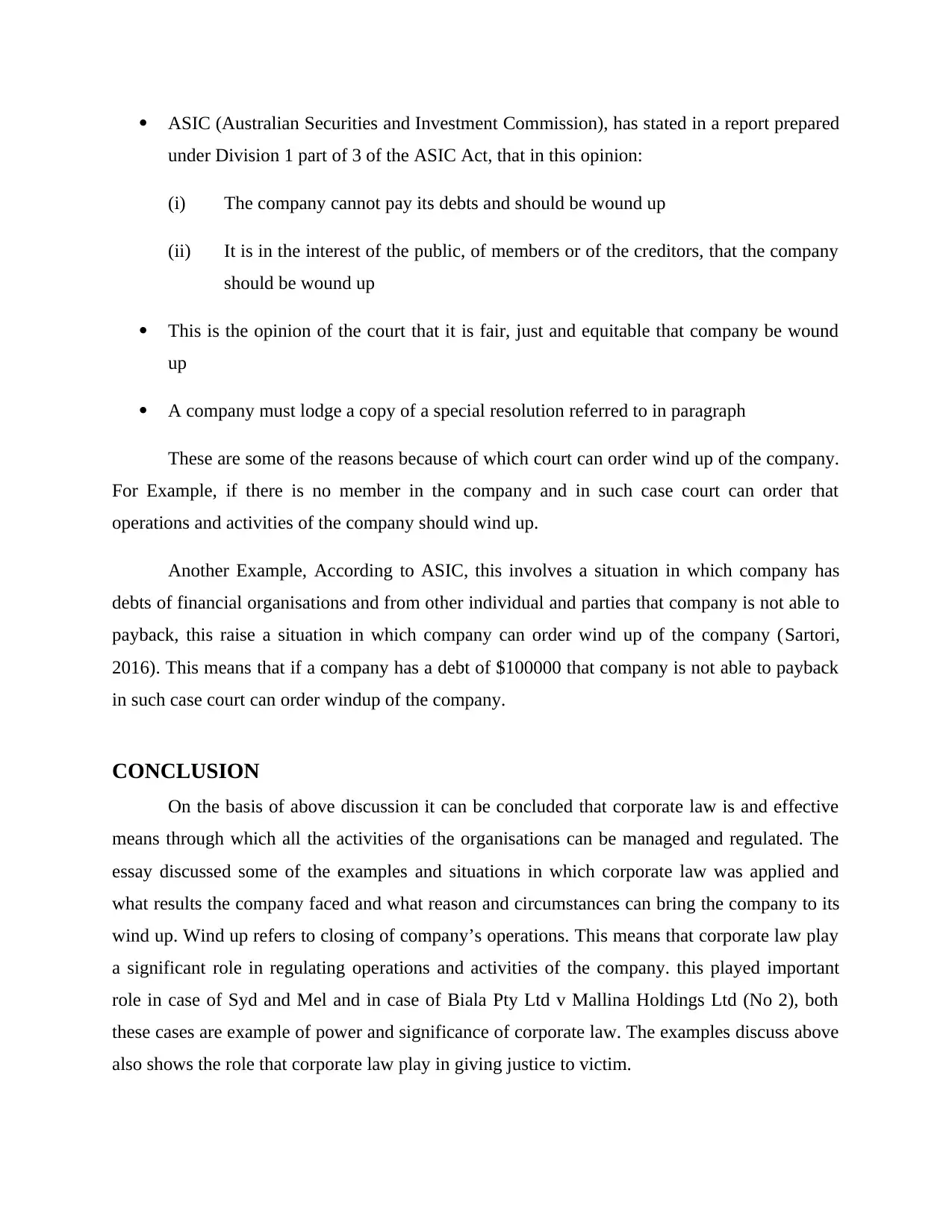
ASIC (Australian Securities and Investment Commission), has stated in a report prepared
under Division 1 part of 3 of the ASIC Act, that in this opinion:
(i) The company cannot pay its debts and should be wound up
(ii) It is in the interest of the public, of members or of the creditors, that the company
should be wound up
This is the opinion of the court that it is fair, just and equitable that company be wound
up
A company must lodge a copy of a special resolution referred to in paragraph
These are some of the reasons because of which court can order wind up of the company.
For Example, if there is no member in the company and in such case court can order that
operations and activities of the company should wind up.
Another Example, According to ASIC, this involves a situation in which company has
debts of financial organisations and from other individual and parties that company is not able to
payback, this raise a situation in which company can order wind up of the company (Sartori,
2016). This means that if a company has a debt of $100000 that company is not able to payback
in such case court can order windup of the company.
CONCLUSION
On the basis of above discussion it can be concluded that corporate law is and effective
means through which all the activities of the organisations can be managed and regulated. The
essay discussed some of the examples and situations in which corporate law was applied and
what results the company faced and what reason and circumstances can bring the company to its
wind up. Wind up refers to closing of company’s operations. This means that corporate law play
a significant role in regulating operations and activities of the company. this played important
role in case of Syd and Mel and in case of Biala Pty Ltd v Mallina Holdings Ltd (No 2), both
these cases are example of power and significance of corporate law. The examples discuss above
also shows the role that corporate law play in giving justice to victim.
under Division 1 part of 3 of the ASIC Act, that in this opinion:
(i) The company cannot pay its debts and should be wound up
(ii) It is in the interest of the public, of members or of the creditors, that the company
should be wound up
This is the opinion of the court that it is fair, just and equitable that company be wound
up
A company must lodge a copy of a special resolution referred to in paragraph
These are some of the reasons because of which court can order wind up of the company.
For Example, if there is no member in the company and in such case court can order that
operations and activities of the company should wind up.
Another Example, According to ASIC, this involves a situation in which company has
debts of financial organisations and from other individual and parties that company is not able to
payback, this raise a situation in which company can order wind up of the company (Sartori,
2016). This means that if a company has a debt of $100000 that company is not able to payback
in such case court can order windup of the company.
CONCLUSION
On the basis of above discussion it can be concluded that corporate law is and effective
means through which all the activities of the organisations can be managed and regulated. The
essay discussed some of the examples and situations in which corporate law was applied and
what results the company faced and what reason and circumstances can bring the company to its
wind up. Wind up refers to closing of company’s operations. This means that corporate law play
a significant role in regulating operations and activities of the company. this played important
role in case of Syd and Mel and in case of Biala Pty Ltd v Mallina Holdings Ltd (No 2), both
these cases are example of power and significance of corporate law. The examples discuss above
also shows the role that corporate law play in giving justice to victim.

⊘ This is a preview!⊘
Do you want full access?
Subscribe today to unlock all pages.

Trusted by 1+ million students worldwide
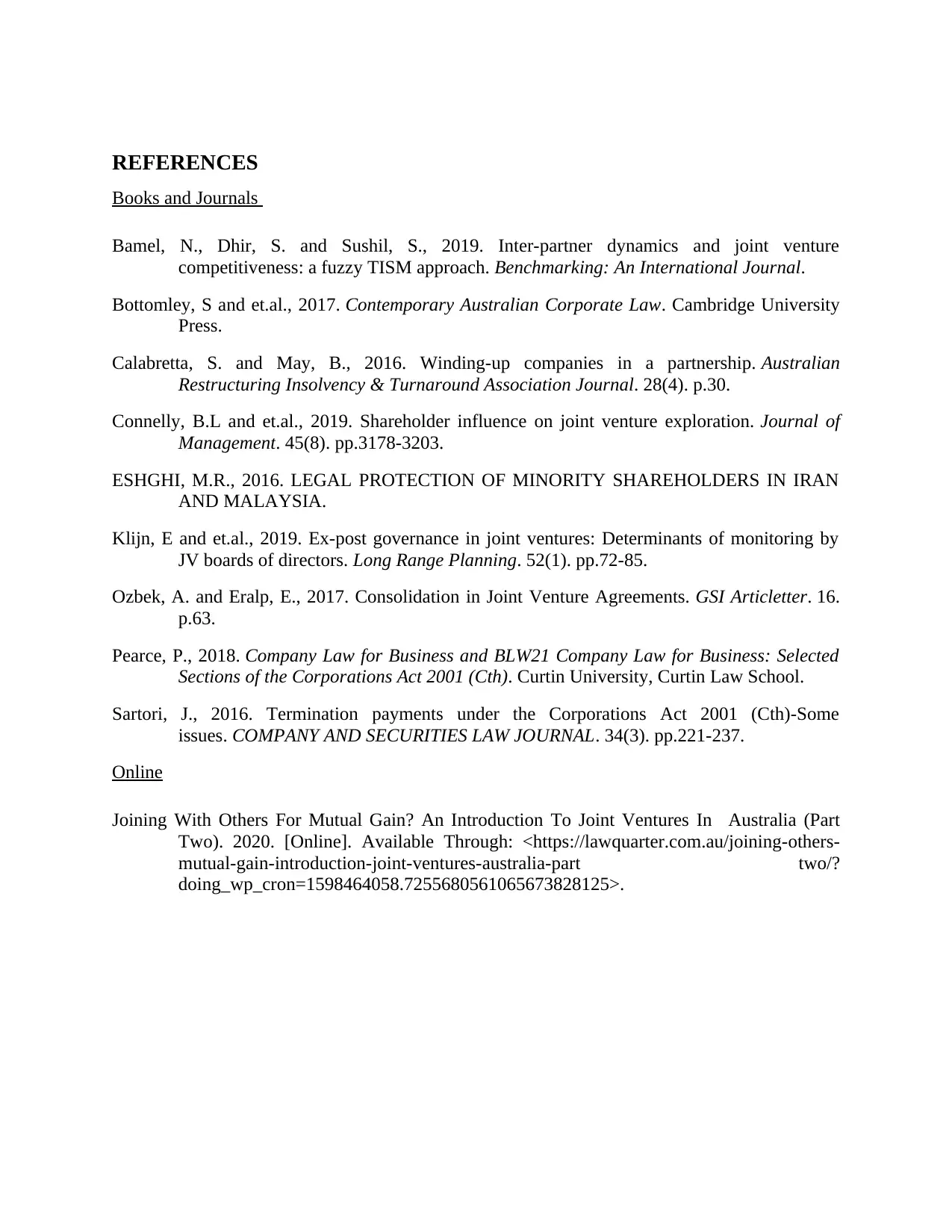
REFERENCES
Books and Journals
Bamel, N., Dhir, S. and Sushil, S., 2019. Inter-partner dynamics and joint venture
competitiveness: a fuzzy TISM approach. Benchmarking: An International Journal.
Bottomley, S and et.al., 2017. Contemporary Australian Corporate Law. Cambridge University
Press.
Calabretta, S. and May, B., 2016. Winding-up companies in a partnership. Australian
Restructuring Insolvency & Turnaround Association Journal. 28(4). p.30.
Connelly, B.L and et.al., 2019. Shareholder influence on joint venture exploration. Journal of
Management. 45(8). pp.3178-3203.
ESHGHI, M.R., 2016. LEGAL PROTECTION OF MINORITY SHAREHOLDERS IN IRAN
AND MALAYSIA.
Klijn, E and et.al., 2019. Ex-post governance in joint ventures: Determinants of monitoring by
JV boards of directors. Long Range Planning. 52(1). pp.72-85.
Ozbek, A. and Eralp, E., 2017. Consolidation in Joint Venture Agreements. GSI Articletter. 16.
p.63.
Pearce, P., 2018. Company Law for Business and BLW21 Company Law for Business: Selected
Sections of the Corporations Act 2001 (Cth). Curtin University, Curtin Law School.
Sartori, J., 2016. Termination payments under the Corporations Act 2001 (Cth)-Some
issues. COMPANY AND SECURITIES LAW JOURNAL. 34(3). pp.221-237.
Online
Joining With Others For Mutual Gain? An Introduction To Joint Ventures In Australia (Part
Two). 2020. [Online]. Available Through: <https://lawquarter.com.au/joining-others-
mutual-gain-introduction-joint-ventures-australia-part two/?
doing_wp_cron=1598464058.7255680561065673828125>.
Books and Journals
Bamel, N., Dhir, S. and Sushil, S., 2019. Inter-partner dynamics and joint venture
competitiveness: a fuzzy TISM approach. Benchmarking: An International Journal.
Bottomley, S and et.al., 2017. Contemporary Australian Corporate Law. Cambridge University
Press.
Calabretta, S. and May, B., 2016. Winding-up companies in a partnership. Australian
Restructuring Insolvency & Turnaround Association Journal. 28(4). p.30.
Connelly, B.L and et.al., 2019. Shareholder influence on joint venture exploration. Journal of
Management. 45(8). pp.3178-3203.
ESHGHI, M.R., 2016. LEGAL PROTECTION OF MINORITY SHAREHOLDERS IN IRAN
AND MALAYSIA.
Klijn, E and et.al., 2019. Ex-post governance in joint ventures: Determinants of monitoring by
JV boards of directors. Long Range Planning. 52(1). pp.72-85.
Ozbek, A. and Eralp, E., 2017. Consolidation in Joint Venture Agreements. GSI Articletter. 16.
p.63.
Pearce, P., 2018. Company Law for Business and BLW21 Company Law for Business: Selected
Sections of the Corporations Act 2001 (Cth). Curtin University, Curtin Law School.
Sartori, J., 2016. Termination payments under the Corporations Act 2001 (Cth)-Some
issues. COMPANY AND SECURITIES LAW JOURNAL. 34(3). pp.221-237.
Online
Joining With Others For Mutual Gain? An Introduction To Joint Ventures In Australia (Part
Two). 2020. [Online]. Available Through: <https://lawquarter.com.au/joining-others-
mutual-gain-introduction-joint-ventures-australia-part two/?
doing_wp_cron=1598464058.7255680561065673828125>.
1 out of 10
Related Documents
Your All-in-One AI-Powered Toolkit for Academic Success.
+13062052269
info@desklib.com
Available 24*7 on WhatsApp / Email
![[object Object]](/_next/static/media/star-bottom.7253800d.svg)
Unlock your academic potential
Copyright © 2020–2025 A2Z Services. All Rights Reserved. Developed and managed by ZUCOL.




